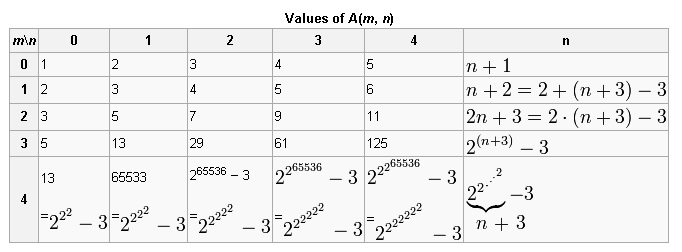The Ackermann function is mathematically defined as:

The Ack function is well-defined total math function which is compute-able but not a primitive recursive function. Its value grow so quickly and become huge with small inputs. It is considered growing faster than exponential value, or even multi-exponential value.
The following is the table of values given small inputs for Ack function.

The Ack function can be easily programmed in most of the languages that support recursive definitions. The implementations are straightforward, similar as the above definition in math. For example, the VBScript implementation is like this.
1 2 3 4 5 6 7 8 9 10 11 | Function Ack(M, N) If M = 0 Then Ack = N + 1 Else If N = 0 Then Ack = Ack(M - 1, 1) Else Ack = Ack(M - 1, Ack(M, N - 1)) End If End If End Function |
Function Ack(M, N)
If M = 0 Then
Ack = N + 1
Else
If N = 0 Then
Ack = Ack(M - 1, 1)
Else
Ack = Ack(M - 1, Ack(M, N - 1))
End If
End If
End FunctionThe Ack function is often used to test the optimization levels of a compiler. With the native implementation, the Ack man will yield ‘stack-over-flow’ error for even small inputs like (4,3).
–EOF (The Ultimate Computing & Technology Blog) —
loading...
Last Post: Codeforces: B. New Problem
Next Post: Using Inline Assembly at Timus Online Judge